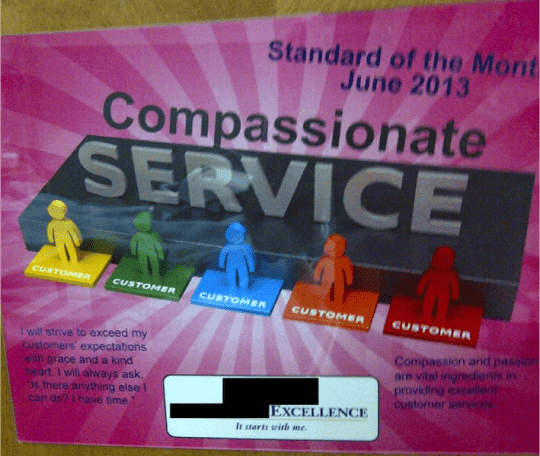A Lean thinking friend's wife had emergency surgery (she is going to be fine) and my friend sent some pictures of Lean-related things he saw at the hospital. The good included:
- Sheets posted on the wall to get staff input on some proposed process changes
- In-room patient info whiteboards that were actually being used and updated (who is my nurse? what is my care plan for today?)
- Evidence of 5S improvement work taking place (with the goal of reducing wasted time for staff)
But, one thing he described as “a visual” seems more like the type of slogan and poster that Dr. W. Edwards Deming warned us about decades ago (read more here).
Here is the poster:
Compassionate service is certainly a great goal. I appreciate that the hospital tries to focus on this.
The organization's Excellence program slogan has a curious slogan:
“It starts with me.”
Really?
I'd say “It includes each and every one of us,” but as Deming said, we can't just rely on everybody's best efforts. We have to work on the system. And management, especially senior leaders, own the system.
Deming said, “Quality starts in the boardroom,” and I think this is true in healthcare.
The sign says, “I strive to exceed my customers' expectations…” but is the system capable of that (the “system” meaning everything from the building, processes, equipment, staffing levels, training, the management system, etc.)?
Staff are encouraged to say “I have time” to the patients. But do the staff REALLY have time? Are they fighting too much waste on a daily basis? Can we really put that burden on staff?
Organizations that practice Lean, like St. Elisabeth in Holland, focus on reducing waste to free up staff time for more caring caring… or “Loving Care” that is more compassionate. This sort of transformation requires the direct involvement and leadership of senior leaders.
Quality starts with me? Compassionate care starts with me? No, it starts with senior leaders.
Also, I think the idea of “visuals” – really expressed as “visual control” or “visual management” is about far more than posters.
A cute sign reminding staff to wash their hands is a poster, not a visual control.
A visual control is something that allows us to do the right thing (like painted lines in a parking lot). A visual control is something like a visual kanban system that tells us to re-order supplies when they physically get down to a certain level, like an empty bin or a taped lined on the side of a cabinet.
“Visual management” is something that prompts management or staff to make a decision. There's no point in seeing a problem through a visual control if we don't take action when we see a problem – both the short-term reaction and longer-term process improvement.
What do you think? Please scroll down (or click) to post a comment. Or please share the post with your thoughts on LinkedIn – and follow me or connect with me there.
Did you like this post? Make sure you don't miss a post or podcast — Subscribe to get notified about posts via email daily or weekly.
Check out my latest book, The Mistakes That Make Us: Cultivating a Culture of Learning and Innovation:












Mark this is great stuff! I recently had an experience at a local hospital here in Toledo, OH that was less than excellent, and it was amazing and frustrating at the same time to be a proponent of continuous improvement in that situation. If this were my hospital, I might say “Excellence and Quality Start With Our Customers (Patients)”. My belief is that focus is what enables the continuous improvement activities that are carried out by the knowledgeable hospital staff to be effective in their end goal, which is serving the patient (or customer). PS – I looked for data posted about measuring patient wait times or any kind of qualitative measurement of service and found none. Should have been my first indicator I suppose.
Good post, Mark. I wonder if their slogan is a variation of the quote often attributed to Gandhi: “Be the change you wish to see” (or some variation of that). While true transformation depends largely on senior leaders, the slogan may serve a useful purpose to remind all levels of employees that part of transformation is deciding to take action and then taking it.
Thanks. We all have a role to play in quality… but we both know many hospitals are just absolutely chaotic environments. It’s unfair to ask individuals to take ownership of a bad system. We all have a big part to play, but I disagree that “it starts with me” or any individual.
It’s not quite as bad of a slogan as “Quality is Everybody’s Responsibility.” That’s true, but I think leadership has more responsibility.
There’s some good discussion on LinkedIn about this post.